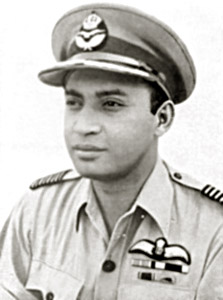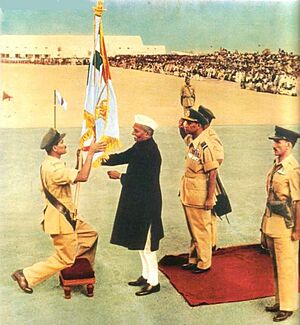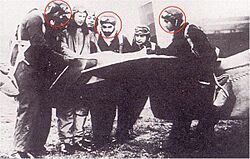Subroto Mukerjee facts for kids
Quick facts for kids
Air Marshal
Subroto Mukerjee
|
|
|---|---|
|
সুব্রত মুখোপাধ্যায়
|
|

Air Marshal Subroto Mukerjee
(pictured wearing Group Captain's insignia, c. 1947) |
|
| 4th Chief of the Air Staff and Commander-in-Chief, Indian Air Force | |
| In office 1 April 1954 – 8 November 1960 (redesignated as Chief of the Air Staff from 1 April 1955) |
|
| Preceded by | Gerald Ernest Gibbs |
| Succeeded by | Aspy Merwan Engineer |
| Personal details | |
| Born | 5 March 1911 Calcutta, Bengal Presidency, British India |
| Died | 8 November 1960 (aged 49) Tokyo, Japan |
| Relations | See Nibaran Chandra Mukherjee family and Das Family |
| Awards | Order of the British Empire |
| Military service | |
| Allegiance | |
| Branch/service | |
| Years of service | 1932–1960 |
| Rank | Air Marshal |
| Unit | No. 1 Squadron IAF |
| Commands | Air Force Station Kohat No. 1 Squadron IAF |
| Battles/wars | Annexation of Hyderabad Indo-Pakistani War of 1947–1948 World War II Waziristan campaign (1936–1939) |
Subroto Mukerjee was a brave Indian military officer. He was the very first Indian to become the Commander-in-Chief of the Indian Air Force (IAF). People often call him the Father of the Indian Air Force.
He earned many awards during his 30-year career. Sadly, his life ended too soon in 1960.
Subroto Mukerjee was born into a well-known Bengali family. He studied in both India and the United Kingdom. He first joined the Royal Air Force. Later, in 1933, he was one of the first people to join the new Indian Air Force.
He flew with the No. 1 Squadron IAF for many years. He fought in the North-West Frontier Province and was recognized for his bravery. He later commanded No. 1 Squadron again in 1942. He also led the RAF Station Kohat from 1943 to 1944. In 1945, he received the OBE award.
After India became independent, he became Deputy Air Commander. In 1954, he was appointed Commander-in-Chief of the IAF. He helped the IAF become a modern force with jet planes. He also led the Chairman of the Chiefs of Staff Committee from 1955.
His sudden death in Tokyo in 1960 shocked the nation. He was given a full military funeral in New Delhi. Subroto Mukerjee achieved many "firsts" for an Indian officer. He was the first Indian to lead a flight, a squadron, an air station, and finally, the entire Indian Air Force.
Contents
Early Life and Education
Subroto Mukerjee was born in Calcutta on March 5, 1911. His family was well-known in Bengal. His father, Satish Chandra Mukherjee, worked for the government. His mother, Charulata Mukherjee, was a social worker.
His grandparents were also important figures. His grandfather, Nibaran Chandra Mukherjee, helped start many social and educational changes in India. His other grandfather, Prasanna Kumar Roy, was the first Indian Principal of Presidency College, Kolkata. His grandmother, Sarala Roy, started the Gokhale Memorial Girls' School.
Subroto was the youngest of four children. He spent his childhood in Krishnanagar and Chinsura in Bengal. From a young age, he showed interest in a military career. His uncle, Flight Lieutenant Indra Lal Roy, was a pilot in the First World War. He was the first Indian to win the Distinguished Flying Cross.
Subroto's older sister, Renuka Ray, was a famous freedom fighter. She became a member of parliament, a government minister, and an ambassador.
Subroto went to several schools, including Nainital Diocesan Boys' High School and Loreto Convent in Calcutta. He also studied at the University of Cambridge in England.
Military Career
Joining the Air Force
In 1928, the British Government allowed Indians to join the Royal Air Force College Cranwell. Subroto Mukerjee was one of the first six Indians chosen for flying training there.
The Indian Air Force (IAF) was created on October 8, 1932. It was a support force for the Royal Air Force. Mukerjee became a pilot officer. After training, he served with the No. 16 Squadron RAF.
On April 1, 1933, the first part of the No. 1 Squadron IAF was formed in Karachi. Mukerjee was one of the five Indian pilots in this group. They flew Westland Wapiti planes. In 1934, he was promoted to flying officer.
In 1936, a rebellion started in the North-West Frontier Province. The Indian Air Force played a big role in stopping it. Mukerjee received the India General Service Medal for his service there.
In 1938, Mukerjee took command of a flight within No. 1 Squadron. In 1939, he became a flight lieutenant. On March 16, 1939, he took command of the entire No. 1 Squadron. He was the first Indian officer to lead a squadron. He led the squadron in action at Miramshah.
World War II and Beyond
When World War II began, Mukerjee was the most senior Indian officer in the IAF. He was promoted to squadron leader in 1939. In 1940, he showed great courage by dropping ammunition to soldiers who were running out. He and his gunner removed bullets from their plane's machine gun and dropped them in socks.
In 1941, Mukerjee attended the Staff College, Quetta. In 1942, he commanded No. 1 Squadron for a second time. In December 1942, he was mentioned in official reports for his excellent service.
From 1943 to 1944, Mukerjee commanded RAF Station Kohat. He was the first Indian officer to lead an airbase. In 1945, he received the Order of the British Empire (OBE). In 1947, he became the first Indian air officer with the rank of air commodore.
After Independence
After India became independent in 1947, Mukerjee helped divide the air force's resources between India and Pakistan. He was appointed Senior Air Staff Officer for the new Indian Air Force.

During the Indo-Pakistani War of 1947, Mukerjee was promoted to air vice marshal. He helped set up an air bridge to deliver supplies to soldiers in the Poonch area. He even flew as a passenger on the first plane to land on a difficult airstrip there.
In 1948, India took action against Hyderabad State. Mukerjee helped guide air operations to support the troops. In 1952, he studied at the Imperial Defence College in London.
Leading the Air Force
On April 1, 1954, Subroto Mukerjee became the Commander-in-Chief of the Indian Air Force. He was given the rank of air marshal. In 1955, his title changed to Chief of the Air Staff (CAS). This made him the first Indian to hold both titles.
From 1955 until his death in 1960, he also served as the Chairman of the Chiefs of Staff Committee. This means he was the top military leader for all three armed forces. During his time as CAS, the IAF grew and became more modern. Old planes were replaced with new jet fighters and bombers.
Awards and Decorations
Subroto Mukerjee received several important awards for his service:
- Indian Independence Medal (1948)
- Order of the British Empire (1945)
- India General Service Medal (1939)
- 1939-1945 Star (1945)
- War Medal 1939-1945 (1945)
- India Service Medal (1945)
- King George VI Coronation Medal (1937)
- Queen Elizabeth II Coronation Medal (1953)
Personal Life
In 1939, Subroto Mukerjee married Sharda Mukherjee. She came from a well-known family in Maharashtra. They had one son.
Sharda Mukerjee was very active in social work. After her husband's death, she became involved in politics. She was elected to the Lok Sabha (Indian Parliament) twice. She also served as the Governor of Andhra Pradesh and later the Governor of Gujarat. She was the first woman governor for both states.
Death
In November 1960, Subroto Mukerjee was visiting Tokyo, Japan. On November 8, 1960, he was having a meal with a friend. Sadly, a piece of food got stuck in his throat, and he choked. He passed away before a doctor could help him.
His body was flown back to Palam Airport in New Delhi. He was given a full military funeral. A 15-gun salute was fired, and his body was carried on a gun carriage. Forty-nine aircraft flew over as a final tribute, one for each year of his life. His death was a great shock to India and the Indian Air Force.
Legacy
Many people remember Subroto Mukerjee as a pioneer of military aviation in India. Air Chief Marshal Pratap Chandra Lal called him the "Father of the Indian Air Force."
Mukerjee loved football. He had the idea for an all-India inter-school football tournament. This tournament, called the Subroto Cup Football Tournament, was started after his death. It still helps find talented young football players from Indian schools today.
A place in Delhi Cantonment is named after him, called Subroto Park. The The Air Force School and the headquarters of the Western Air Command are located there. The Centre for Air Power Studies also holds an annual seminar named after him.
See also
- Field Marshal K. M. Cariappa
- Admiral Ram Dass Katari


